What is the full form of MBOMBO: Management by ObjectivesMBO stands for Management by Objectives. The goal of the strategic management paradigm known as "management by objectives" (M.B.O.) is to increase an organization's performance by establishing goals that both management and people can support. 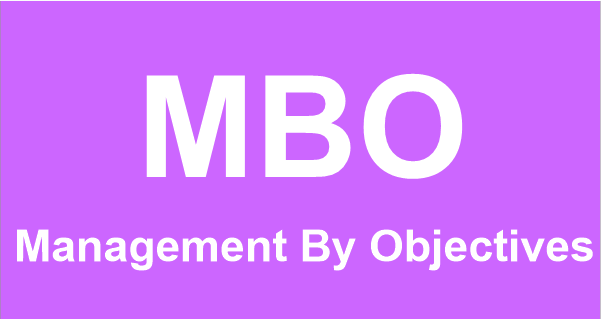
An Overview on Management by ObjectivesThe construction of a management information system (M.I.S.) to compare actual performance and accomplishments with the stated targets is known as management by objectives (also known as management by planning). According to practitioners, M.B.O.'s main advantages are increased employee commitment and motivation and improved management-employee communication. However, a criticism of M.B.O. is that it needs to emphasize goal-setting to achieve objectives rather than developing a systematic plan to accomplish. So, M.B.O. is criticized by W. Edwards Deming, who claims that when workers are given specific objectives like output targets, they will use whatever means necessary to reach them, including low-quality shortcuts. Peter Drucker outlined several M.B.O. guiding principles in his book that popularised the phrase. With the assistance of the staff, objectives are set, and they should be difficult but doable. The emphasis is on personal development and growth rather than disappointment over not meeting goals. Daily feedback is given to employees, and incentives rather than sanctions are the main focus. M.B.O. is a tool that should be used, not a panacea. It provides organizations with a methodology, with many practitioners stating that top management support, well-defined objectives, and trained managers who can implement it are necessary for M.B.O. to be successful. Key Lessons
Steps for Management by Objectives (M.B.O.)M.B.O. provides five actions that businesses should follow to use the management method. 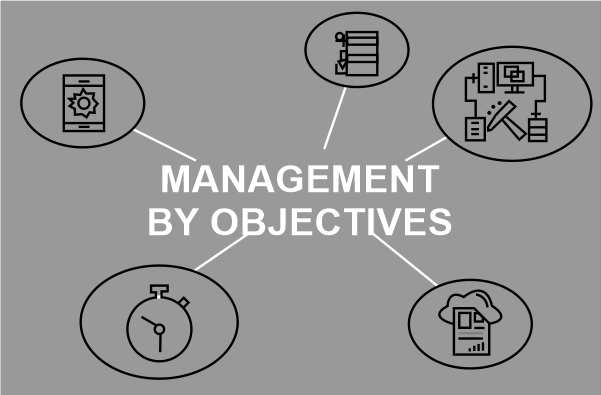
Benefits and Drawbacks of Management by Objectives (M.B.O.)Both benefits and drawbacks of M.B.O. exist. Advantages
Disadvantages
What Aims does Management by Objectives (M.B.O.) Pursue?Using a set of quantifiable or objective benchmarks, management by objectives (M.B.O.) assesses an organization's and its personnel's performance. Peter Drucker originally popularised management by objectives (M.B.O.), also referred to as management by planning (M.B.P.), in his 1954 book The Practice of Management. The process of setting precise organizational goals that management can communicate to team members, then selecting how to accomplish each goal individually, is known as management by objectives. To maintain a calm yet productive work environment, managers might use this technique to tackle tasks one at a time. Individual goals and organizational goals are aligned in this management system. Measuring and comparing an employee's performance to the specified standards is a crucial component of M.B.O. The best scenario is when employees have participated in the goal-setting process. Employees are more likely to carry out their obligations when actively formulating goals and selecting the course of action to take. 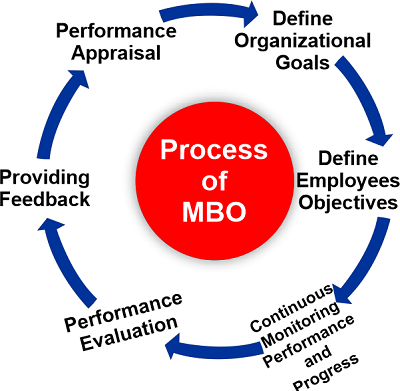
M.B.O. establishes goals for employees so they know their work responsibilities. With the aid of Management by Objectives, employees may plan out their future courses of action within the company and are given clear definitions of their tasks and duties. The system of management by objectives, according to George S. Odiorne, can be characterized as a procedure where the superior and subordinate jointly identify common goals, define each individual's major areas of responsibility in terms of the results expected of them, and use these measures as guidelines for running the unit and evaluating the contribution of each of its members. Background Of M.B.O.In his book 'The Practice of Management from 1954', Peter Drucker coined the phrase "management by objectives." Although Drucker did not develop the fundamental concepts of M.B.O., they drew on other management techniques to form a comprehensive "system", the essay 'The Giving of Orders' by Mary Parker Follett from 1926 is a foundation for the theory. 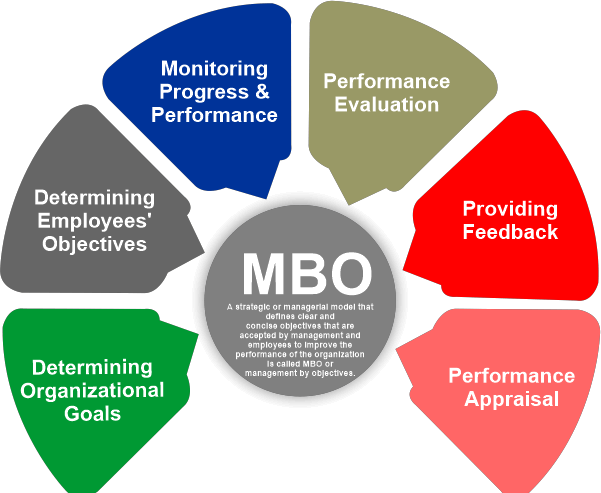
George Odiorne, a student of Drucker's who coined the phrase and the concept, expanded on it in his book 'Management Decisions by Objectives', which was released in the middle of the 1960s. Businesses like Hewlett-Packard asserted that M.B.O. contributed to their success and promoted the concept. Idea and StructureAt its core, management by objectives is the process by which managers/supervisors try to control their employees by introducing a list of precise goals that both the employee and the organization hope to accomplish shortly and then working to attain those goals following them. Utilization in Daily LifeThe application of management by objectives is limitless. In a company or group, one must identify precise objectives to strive for. Many eminent businesses have adopted M.B.O. The computer manufacturer Hewlett-Packard (H.P.) management has stated that the policy is a key factor in the company's success. Other businesses, including Xerox, DuPont, Intel, and countless more, laud the success of M.B.O. Businesses that employ M.B.O.s frequently report higher revenue and organizational productivity. Some goals are shared by all employees, while others can be personal objectives. Both help the workers see what needs to be done and how it should be done, making the task seem manageable. 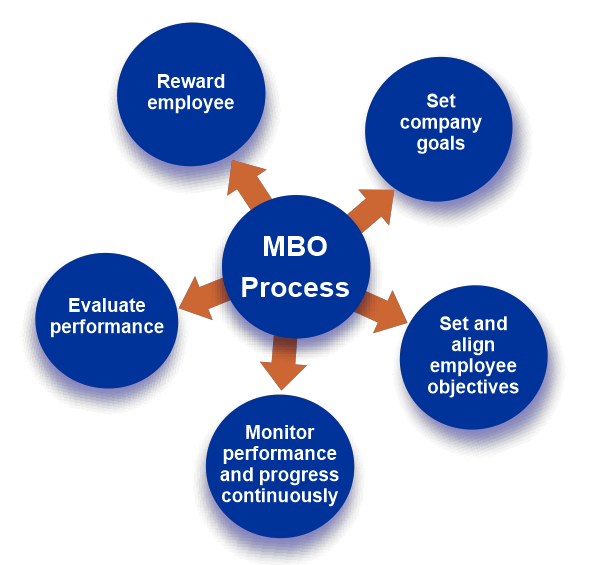
In the M.B.O. paradigm, management decides on the mission and long-term objectives of the company. Top-level managers base their goals on examining what the organization can and should accomplish in time. By choosing a project manager to oversee and manage the operations of the many departments, the duties of these managers can be centralized. Each manager's contributions to the corporate goal should be made apparent if this is not possible or desirable. Beginning in the late 1990s, "the performance-based merit system" (seika-shugi), which employed precise numerical targets to measure performance in contrast to the prior system of non-specific contracts in Japanese companies, was based on M.B.O. in many significant Japanese corporations. Objectives must be monitored and quantified. Establishing pertinent goals and keeping an eye on their "reach ratio" objectively require reliable management information systems. Pay incentives (bonuses) are frequently correlated with success in achieving goals. In this paradigm, the process of creating objectives is referred to as S. M.A.R.T. "SMART" goals include:
"What gets measured gets done", is a maxim that is consistent with the M.B.O. way of thinking. More Limitations
Moreover, according to Deming, establishing production goals will motivate employees to fulfil them by whatever means necessary, typically resulting in subpar quality.Point 7 of Deming's guiding principles exhorts managers to forego targets in favour of leadership because, in his opinion, a leader who comprehends systems is more likely to lead employees to the right answer than an aim that provides incentives. Deming also emphasized Drucker's admonition to managers that a systemic perspective was necessary and felt that M.B.O. practitioners mostly disregarded Drucker's advice. The underlying hypotheses about the effects of management by objectives have limitations like:
This context covers a wide range of factors, including stakeholder and leadership relative buy-in and the quantity and quality of resources available. Only 6% of businesses with uncommitted C.E.O.s experienced increased productivity. Self-centred employees may be inclined to inflate achievements when this approach needs to be properly established, accepted and controlled by organizations, indicating the achievement of targets that were set in a short-term, restricted manner. Setting goals would be unhelpful in this situation. As mentioned earlier, the drawbacks and difficulties faced by contemporary service businesses have prompted the creation of techniques that incorporate M.B.O.'s best practices but seem far more practical in practice. One of these is the Objectives and Key Results (O.K.R.) system, which John Doerr and colleagues developed and has been successfully used in numerous businesses, most notably Google. The use of agile management strategies places a priority on goals. Management by Goals approach is a collection of goal-based management strategies prioritizing teamwork, leadership, and involvement. 
According to a recent study, Management by Objectives is being used today with an emphasis on planning and development to help different businesses. The most recent research focuses on particular industries and details M.B.O. usage for each. Additionally, the OPTIMAL MBO formula was introduced in 2016 in response to criticism of the original M.B.O. approach. Future planning is a more common activity, and although the practice is still in use today, it may go by new titles because the letters "M.B.O." have lost their formality. Best Practices for MBOGoalsGoals are established for the CEO, department executives, team leaders, and sole contributors. Everyone will then understand what they are expected to bring to the team and how it fits into the overall scheme. ObjectivesObjectives are crucial to ensure that everyone who contributes uses their time at work productively and is working towards a common goal. They also show employees at a corporation how much they can do in a given period. During the review process, they might change quarterly goals to be more ambitious if they are too simple or vice versa. Aspirational goals must be established to provide employees with a genuine challenge. We advise setting up three objectives. Employees are compelled to determine their top priorities as a result. According to Peter Drucker, do the most important things first and the rest later. QuantifyAnother guideline is to quantify your goals so that you can clearly define success, which is crucial for the evaluation process. Rules like these are useful recommendations but only sometimes have to be followed. Top corporate objectives are occasionally intangible. For instance, company culture is a significant asset that merits high consideration even though it is challenging to measure. You might be interested in OKRs if you're interested in MBOs (objectives and key results). This method of goal-setting and tracking management is comparable. Performance EvaluationsThe process of reviewing performance makes flaws and errors easier to find. It also enables a brainstorming session on the business's potential changes to continue achieving its core goals.
Next TopicFull Forms List
|
 For Videos Join Our Youtube Channel: Join Now
For Videos Join Our Youtube Channel: Join Now
Feedback
- Send your Feedback to [email protected]
Help Others, Please Share










